Arman Farhang
Waveform-domain NOMA: An Enabler for ISAC in Uplink Transmission
Nov 11, 2025Abstract:According to the recent 3GPP decisions on 6G air interface, orthogonal frequency-division multiplexing (OFDM)-based waveforms are the primary candidates for future integrated sensing and communication (ISAC) systems. In this paper, we consider a monostatic sensing scenario in which OFDM is used for the downlink and its reflected echo signal is used for sensing. OFDM and discrete Fourier transform-spread OFDM (DFT-s-OFDM) are the options for uplink transmission. When OFDM is used in the uplink, the power difference between this signal and the echo signal leads to a power-domain non-orthogonal multiple access (PD-NOMA) scenario. In contrast, adopting DFT-s-OFDM as uplink signal enables a waveform-domain NOMA(WD-NOMA). Affine frequency-division multiplexing (AFDM) and orthogonal time frequency space (OTFS) have been proven to be DFT-s-OFDM based waveforms. This work focuses on such a WD-NOMA system, where AFDM or OTFS is used as uplink waveform and OFDM is employed for downlink transmission and sensing. We show that the OFDM signal exhibits additive white Gaussian noise (AWGN)-like behavior in the affine domain, allowing it to be modeled as white noise in uplink symbol detection. To enable accurate data detection performance, an AFDM frame design and a noise power estimation (NPE) method are developed. Furthermore, a two-dimensional orthogonal matching pursuit (2D-OMP) algorithm is applied for sensing by iteratively identifying delay-Doppler components of each target. Simulation results demonstrate that the WD-NOMA ISAC system, employing either AFDM or OTFS, outperforms the PD-NOMA ISAC system that uses only the OFDM waveform in terms of bit error rate (BER) performance. Furthermore, the proposed NPE method yields additional improvements in BER.
A Unified Framework for Adaptive Waveform Processing in Next Generation Wireless Networks
Oct 14, 2025



Abstract:The emergence of alternative multiplexing domains to the time-frequency domains, e.g., the delay-Doppler and chirp domains, offers a promising approach for addressing the challenges posed by complex propagation environments and next-generation applications. Unlike the time and frequency domains, these domains offer unique channel representations which provide additional degrees of freedom (DoF) for modeling, characterizing, and exploiting wireless channel features. This article provides a comprehensive analysis of channel characteristics, including delay, Doppler shifts, and channel coefficients across various domains, with an emphasis on their inter-domain relationships, shared characteristics, and domain-specific distinctions. We further evaluate the comparative advantages of each domain under specific channel conditions. Building on this analysis, we propose a generalized and adaptive transform domain framework that leverages the pre- and post-processing of the discrete Fourier transform (DFT) matrix, to enable dynamic transitions between various domains in response to the channel conditions and system requirements. Finally, several representative use cases are presented to demonstrate the applicability of the proposed cross-domain waveform processing framework in diverse scenarios, along with future directions and challenges.
Time and Frequency Synchronization for Multiuser OTFS in Uplink
Jul 23, 2025Abstract:In this paper, we propose time and frequency synchronization techniques for uplink multiuser OTFS (MU-OTFS) systems in high-mobility scenarios. This work focuses on accurately estimating and correcting timing offsets (TOs) and carrier frequency offsets (CFOs). Specifically, TO estimation is essential for locating users' pilots on the delay-time plane, while CFO estimation enhances channel estimation accuracy. First, we propose a TO estimation technique for an existing multiuser pilot structure in MU-OTFS. We replace the impulse pilot (IMP) in this pilot structure with a more practical pilot with a cyclic prefix (PCP), referred to as single-user-inspired PCP (SU-PCP). This structure employs different Zadoff-Chu (ZC) sequences, which enables pilot separation via correlation at the receiver side. Consequently, we introduce a correlation-based TO estimation technique for uplink MU-OTFS using this pilot structure. Next, a spectrally efficient and practical pilot pattern is proposed, where each user transmits a PCP within a shared pilot region on the delay-Doppler plane, referred to as MU-PCP. At the receiver, the second TO estimation technique utilizes a bank of filters to separate different users' signals and accurately estimate their TOs. Then, we derive a mathematical threshold range to enhance TO estimation accuracy by finding the first major peak in the correlation function rather than relying solely on the highest peak. After locating the received users' pilot signals using one of the proposed TO estimation techniques, our proposed CFO estimation technique reduces the multi-dimensional maximum likelihood (ML) search problem into multiple one-dimensional search problems. In this technique, we apply the Chebyshev polynomials of the first kind basis expansion model (CPF-BEM) to effectively handle the time-variations of the channel in obtaining the CFO estimates for all the users.
PAPR of DFT-s-OTFS with Pulse Shaping
Jul 16, 2025Abstract:Orthogonal Time Frequency Space (OTFS) suffers from high peak-to-average power ratio (PAPR) when the number of Doppler bins is large. To address this issue, a discrete Fourier transform spread OTFS (DFT-s-OTFS) scheme is employed by applying DFT spreading across the Doppler dimension. This paper presents a thorough PAPR analysis of DFT-s-OTFS in the uplink scenario using different pulse shaping filters and resource allocation strategies. Specifically, we derive a PAPR upper bound of DFT-s-OTFS with interleaved and block Doppler resource allocation schemes. Our analysis reveals that DFT-s-OTFS with interleaved allocation yields a lower PAPR than that of block allocation. Furthermore, we show that interleaved allocation produces a periodic time-domain signal composed of repeated quadrature amplitude modulated (QAM) symbols which simplifies the transmitter design. Based on our analytical results, the root raised cosine (RRC) pulse generally results in a higher maximum PAPR compared to the rectangular pulse. Simulation results confirm the validity of the derived PAPR upper bounds. Furthermore, we also demonstrate through BER simulation analysis that the DFT-s-OTFS gives the same performance as OTFS without DFT spreading.
Time Frequency Localized Pulse for Delay Doppler Domain Data Transmission
Jan 30, 2025Abstract:Orthogonal time frequency space (OTFS) is a strong candidate waveform for sixth generation wireless communication networks (6G), which can effectively handle time varying wireless channels. In this paper, we analyze the effect of fractional delay in delay Doppler (DD) domain multiplexing techniques. We develop a vector-matrix input-output relationship for the DD domain data transmission system by incorporating the effective pulse shaping filter between the transmitter and receiver along with the channel. Using this input-output relationship, we analyze the effect of the pulse shaping filter on the channel estimation and BER performance in the presence of fractional delay and uncompensated fractional timing offset (TO). For the first time, we propose the use of time-frequency localized (TFL) pulse shaping for the OTFS waveform to overcome the interference due to fractional delays. We show that our proposed TFL-OTFS outperforms the widely used raised cosine pulse-shaped OTFS (RC-OTFS) in the presence of fractional delays. Additionally, TFL-OTFS also shows very high robustness against uncompensated fractional TO, compared to RC-OTFS.
Delay-Doppler Multiplexing With Global Filtering
Jan 23, 2025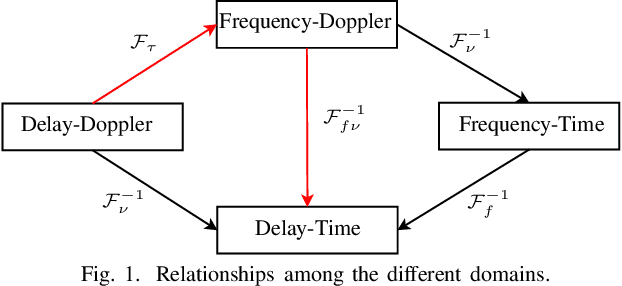
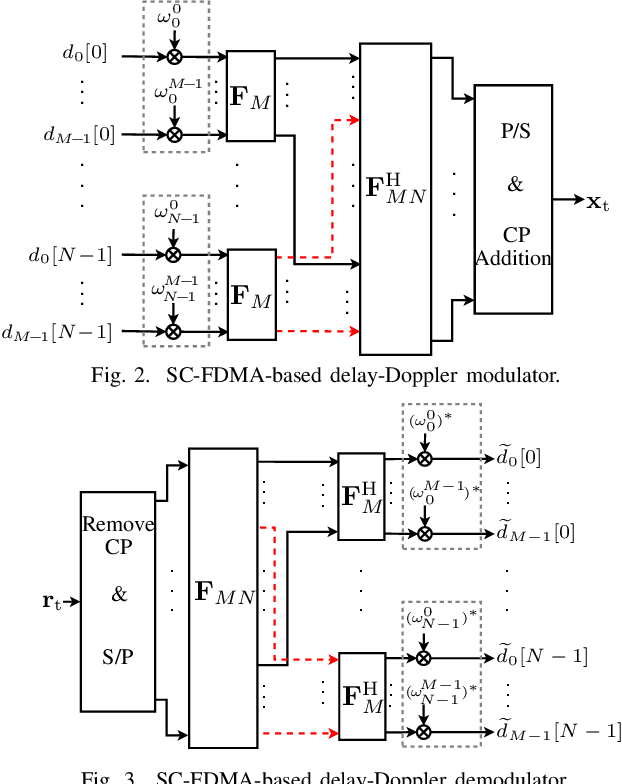
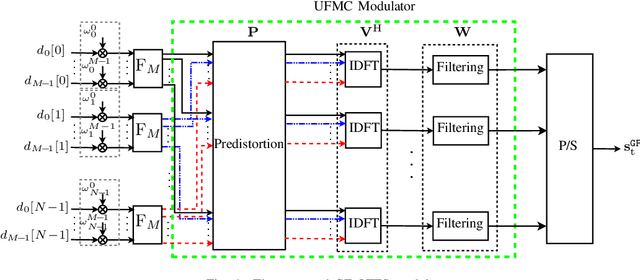
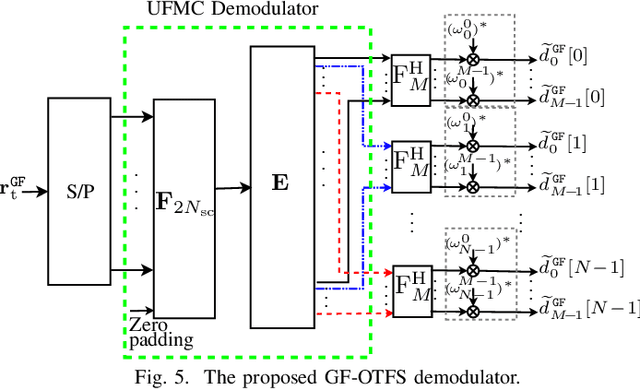
Abstract:This paper proposes a novel modulation technique called globally filtered orthogonal time frequency space (GF-OTFS) which integrates single-carrier frequency division multiple access (SC-FDMA)-based delay-Doppler representation with universal filtered multi-carrier (UFMC) modulation. Our proposed technique first arranges the frequency-Doppler bins of an orthogonal time frequency space (OTFS) frame in adjacency using SC-FDMA and then applies universal filtering to the neighboring signals to mitigate inter-Doppler interference (IDI). By employing this approach, GF-OTFS achieves superior spectral containment and effectively mitigates interference caused by Doppler shifts in dynamic, time-varying channels. This paper also presents a detailed mathematical formulation of the proposed modulation technique. Furthermore, a comprehensive performance evaluation is conducted, comparing our GF-OTFS approach to state-of-the-art techniques, including Doppler-resilient UFMC (DR-UFMC) and receiver windowed OTFS (RW-OTFS). Key performance metrics, such as bit error rate (BER) and out-of-band (OOB) emissions, as well as the Doppler spread reduction are analyzed to assess the effectiveness of each approach. The results indicate that our proposed technique achieves comparable BER performance while significantly improving spectral containment.
Windowed Dictionary Design for Delay-Aware OMP Channel Estimation under Fractional Doppler
Dec 02, 2024Abstract:Delay-Doppler (DD) signal processing has emerged as a powerful tool for analyzing multipath and time-varying channel effects. Due to the inherent sparsity of the wireless channel in the DD domain, compressed sensing (CS) based techniques, such as orthogonal matching pursuit (OMP), are commonly used for channel estimation. However, many of these methods assume integer Doppler shifts, which can lead to performance degradation in the presence of fractional Doppler. In this paper, we propose a windowed dictionary design technique while we develop a delay-aware orthogonal matching pursuit (DA-OMP) algorithm that mitigates the impact of fractional Doppler shifts on DD domain channel estimation. First, we apply receiver windowing to reduce the correlation between the columns of our proposed dictionary matrix. Second, we introduce a delay-aware interference block to quantify the interference caused by fractional Doppler. This approach removes the need for a pre-determined stopping criterion, which is typically based on the number of propagation paths, in conventional OMP algorithm. Our simulation results confirm the effective performance of our proposed DA-OMP algorithm using the proposed windowed dictionary in terms of normalized mean square error (NMSE) of the channel estimate. In particular, our proposed DA-OMP algorithm demonstrates substantial gains compared to standard OMP algorithm in terms of channel estimation NMSE with and without windowed dictionary.
Reduced Overhead Channel Estimation for OTFS With Split Pilot
Oct 15, 2024
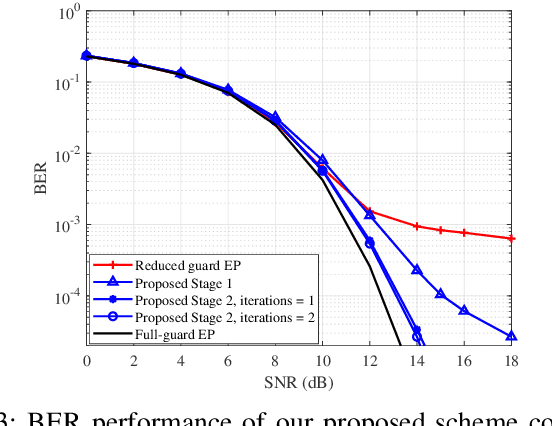
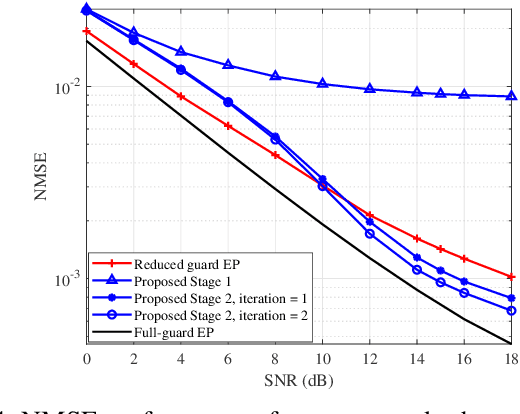

Abstract:Orthogonal time frequency space modulation (OTFS) is currently one of the most robust modulation techniques for high Doppler channels. However, to reap the benefits of OTFS, an accurate channel estimation is crucial. To this mean, the widely used embedded pilot structures use twice the channel length size as a delay guard to avoid interference between the pilot and data symbols. Hence, incurring a large spectral efficiency loss, especially in wideband systems where the channel length is large. To reduce the pilot overhead, we propose a novel split pilot structure with two impulse pilots. With two pilots, we can use one to cancel the other, thus, capable of removing the pilot interference over data. To remove the data interference from the pilot, we also propose an iterative joint channel estimation and detection technique tailored to the proposed split pilot structure. With the interference caused by the delay spread solved, we reduce the number of delay guards in our system by half, significantly improving the spectral efficiency. To corroborate our claims, we numerically demonstrate that our proposed method can achieve performance levels comparable to that of the full-guard method while using only half the delay guard. Additionally, we show that our proposed iterative channel estimating technique has a fast convergence speed, requiring only two iterations.
Synchronization for Multiuser Uplink OTFS
Oct 14, 2024



Abstract:In this paper, we propose time and frequency synchronization techniques for the uplink of multiuser OTFS (MU-OTFS) in high-mobility scenarios. We introduce a spectrally efficient and practical pilot pattern where each user utilizes a pilot with a cyclic prefix (PCP) within a shared pilot region on the delay-Doppler plane. At the receiver, a bank of filters is deployed to separate the users' signals and accurately estimate their timing offsets (TOs) and carrier frequency offsets (CFOs). Our technique employs a threshold-based approach that provides precise TO estimates. Our proposed CFO estimation technique reduces the multi-dimensional maximum likelihood (ML) search problem into multiple one-dimensional search problems. Furthermore, we apply the Chebyshev polynomials of the first kind basis expansion model (CPF-BEM) to effectively handle the time-variations of the channel in obtaining the CFO estimates for all the users. Finally, we numerically investigate the error performance of our proposed synchronization technique in high mobility scenarios for the MU-OTFS uplink. Our simulation results confirm the efficacy of the proposed technique in estimating the TOs and CFOs which also leads to an improved channel estimation performance.
Exploring the Impact of HAPS-RIS on UAV-based Networks: A Novel Architectural Approach
Sep 26, 2024



Abstract:In this paper, we propose a network architecture where two types of aerial infrastructures together with a ground station provide connectivity to a remote area. A high altitude platform station (HAPS) is equipped with reconfigurable intelligent surface (RIS), so-called HAPS-RIS, to be exploited to assist the unmanned aerial vehicle (UAV)-based wireless networks. A key challenge in such networks is the restricted number of UAVs, which limits full coverage and leaves some users unsupported. To tackle this issue, we propose a hierarchical bilevel optimization framework including a leader and a follower problem. The users served by HAPS-RIS are in a zone called HAPS-RIS zone and the users served by the UAVs are in another zone called UAV zone. In the leader problem, the goal is to establish the zone boundary that maximizes the number of users covered by HAPS-RIS while ensuring that users in this zone meet their rate requirements. This is achieved through an algorithm that integrates RIS clustering, subcarrier allocation, and zone determination. The follower problem focuses on minimizing the number of UAVs required, ensuring that the rate requirements of the users in the UAV zone are met. This is addressed using an algorithm that employs k-means clustering and subcarrier allocation. Our study reveals that increasing the number of RIS elements significantly decreases the number of required UAVs.
 Add to Chrome
Add to Chrome Add to Firefox
Add to Firefox Add to Edge
Add to Edge